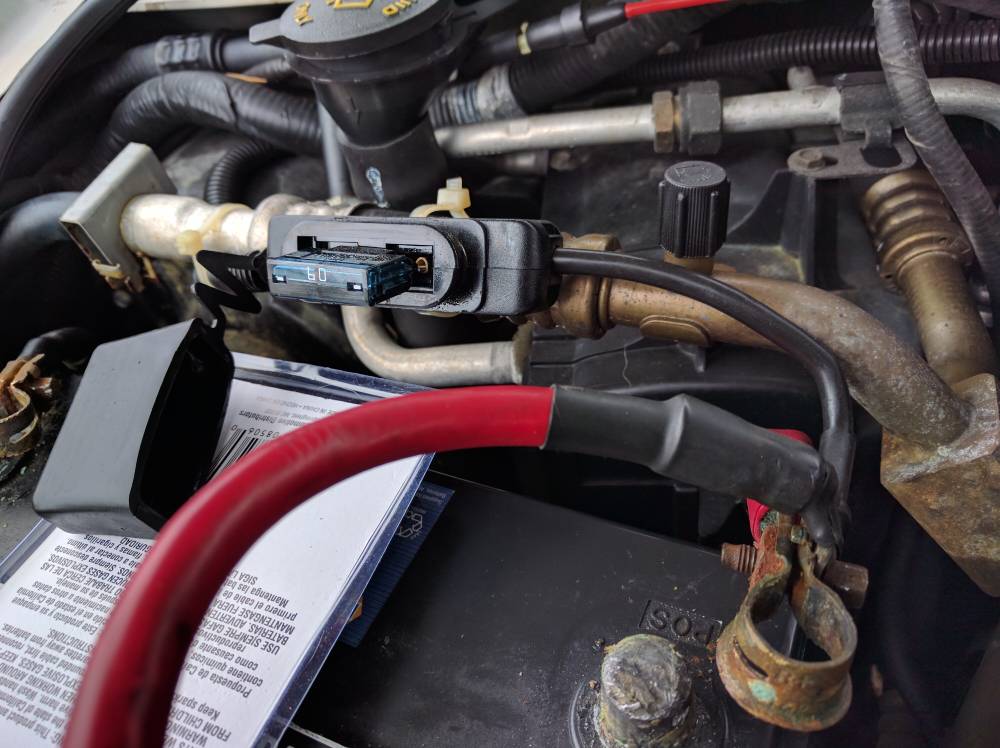TooManyDogs
Well-known member
- Joined
- Nov 7, 2015
- Messages
- 164
- Reaction score
- 0
Hi all!
So, the van is still at the shop. The alternator rebuild was a bust (after reinstallation, I took the van to Oreilly and the diodes failed). My friend will take it back to the rebuild place and gave them fix it.
In the meanwhile, I watched Bob's CDS video and decided to trace the wires that powered the (removed) wheelchair lift back from the start battery.
3 wires come off the (+) post of the battery:
1) to power the van as usual
2) the wheelchair lift wire. Connects to a circuit breaker, then run through the engine compartment and under the van, up a hole to the back of the van. 2 other wires go up that hole, I'm assuming they're grounds.
3) ? with a 60amp fuse, through the engine compartment and then I lost it.
I want to install a CDS in the van and am going to replace that circuit breaker with a CDS and stall a bunch of fuses inline.
My questions are:
1) Wire 3: What could this be for? Could it be the switch in the dash of the van? How do I find out? Is there a trick to following wires under the van? Will this affect the CDS?
 (As you can see, the battery is disconnected and my friend is going to replace the terminals.)
(As you can see, the battery is disconnected and my friend is going to replace the terminals.)
2) How to find a "live when key is turned on circuit" on the power distribution box under the hood. Do I stick the (+) end of the multimeter in the hole and the (-) on the frame? Is it better to find a relay slot or a fuse slot? Does it matter?
3) I found a diagram of the relays of the van. I have a relay in position E (trailer battery charge relay). I don't have a trailer or a battery. Can I unplug this to test the slot? Probably a bad idea, right? (The reason I'm asking about this one is that's the slot in the video that they wired into to energize the CDS. How consistent was Ford with regards to fuse/relay positions inside the box?)
4) Random question: what is this that's on the side of the power distribution box. The plastic cover is labeled "ALT" and "+".

Thanks for your help. I feel like I'm everywhere and have so many seemingly random questions because I'm not really sure what anything is. I'm just guessing.
So, the van is still at the shop. The alternator rebuild was a bust (after reinstallation, I took the van to Oreilly and the diodes failed). My friend will take it back to the rebuild place and gave them fix it.
In the meanwhile, I watched Bob's CDS video and decided to trace the wires that powered the (removed) wheelchair lift back from the start battery.
3 wires come off the (+) post of the battery:
1) to power the van as usual
2) the wheelchair lift wire. Connects to a circuit breaker, then run through the engine compartment and under the van, up a hole to the back of the van. 2 other wires go up that hole, I'm assuming they're grounds.
3) ? with a 60amp fuse, through the engine compartment and then I lost it.
I want to install a CDS in the van and am going to replace that circuit breaker with a CDS and stall a bunch of fuses inline.
My questions are:
1) Wire 3: What could this be for? Could it be the switch in the dash of the van? How do I find out? Is there a trick to following wires under the van? Will this affect the CDS?

2) How to find a "live when key is turned on circuit" on the power distribution box under the hood. Do I stick the (+) end of the multimeter in the hole and the (-) on the frame? Is it better to find a relay slot or a fuse slot? Does it matter?
3) I found a diagram of the relays of the van. I have a relay in position E (trailer battery charge relay). I don't have a trailer or a battery. Can I unplug this to test the slot? Probably a bad idea, right? (The reason I'm asking about this one is that's the slot in the video that they wired into to energize the CDS. How consistent was Ford with regards to fuse/relay positions inside the box?)
4) Random question: what is this that's on the side of the power distribution box. The plastic cover is labeled "ALT" and "+".

Thanks for your help. I feel like I'm everywhere and have so many seemingly random questions because I'm not really sure what anything is. I'm just guessing.
































































